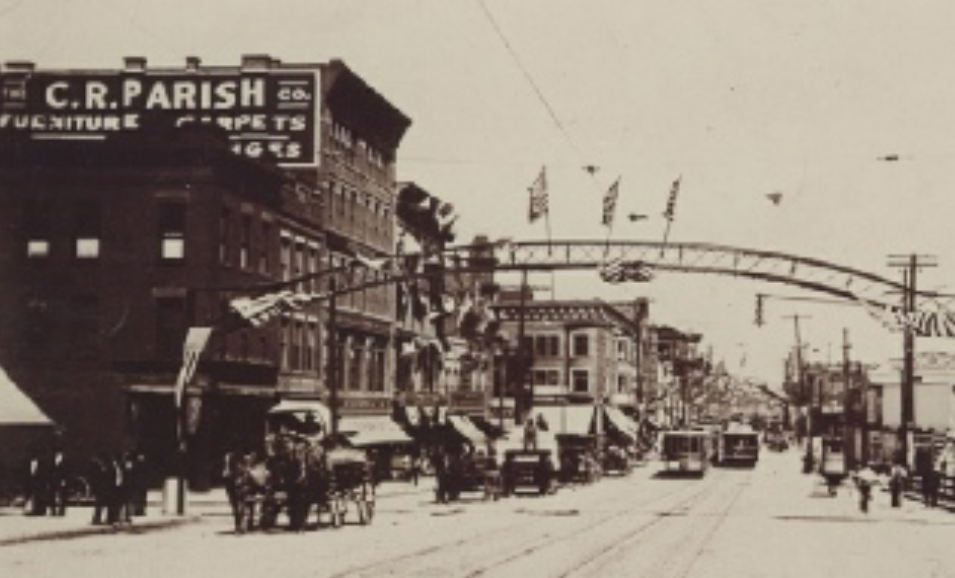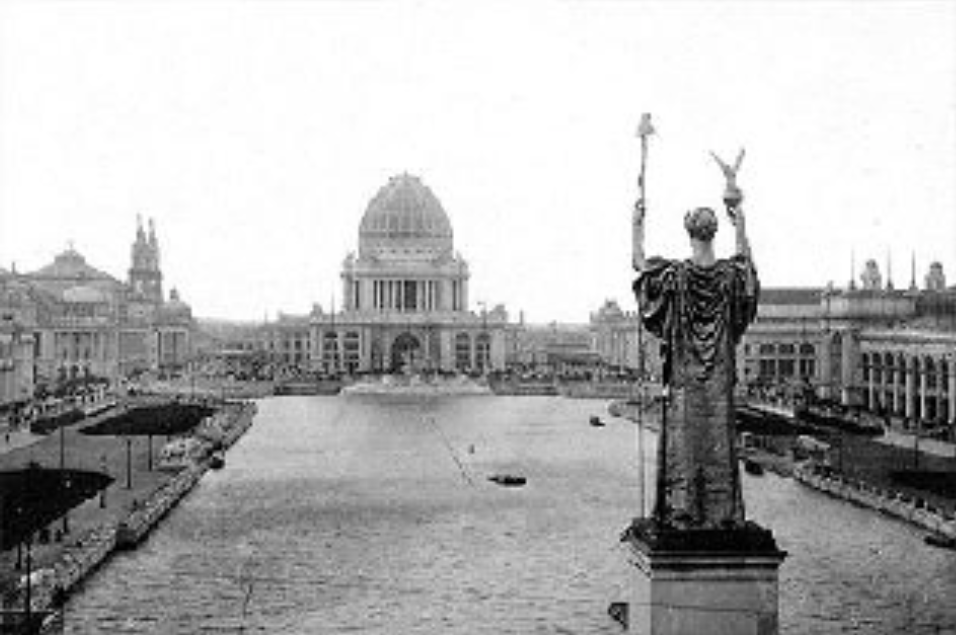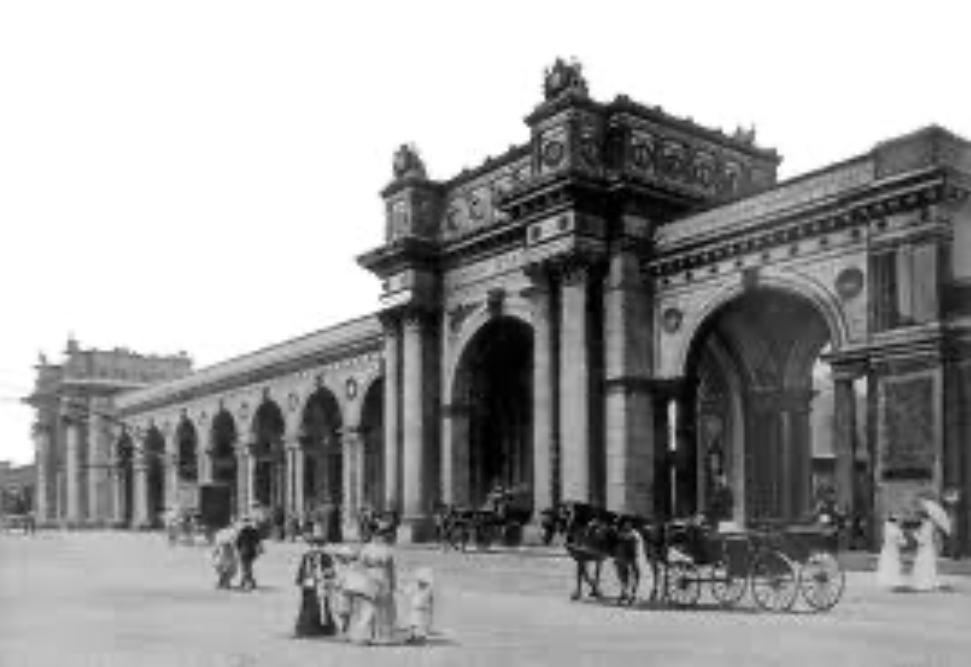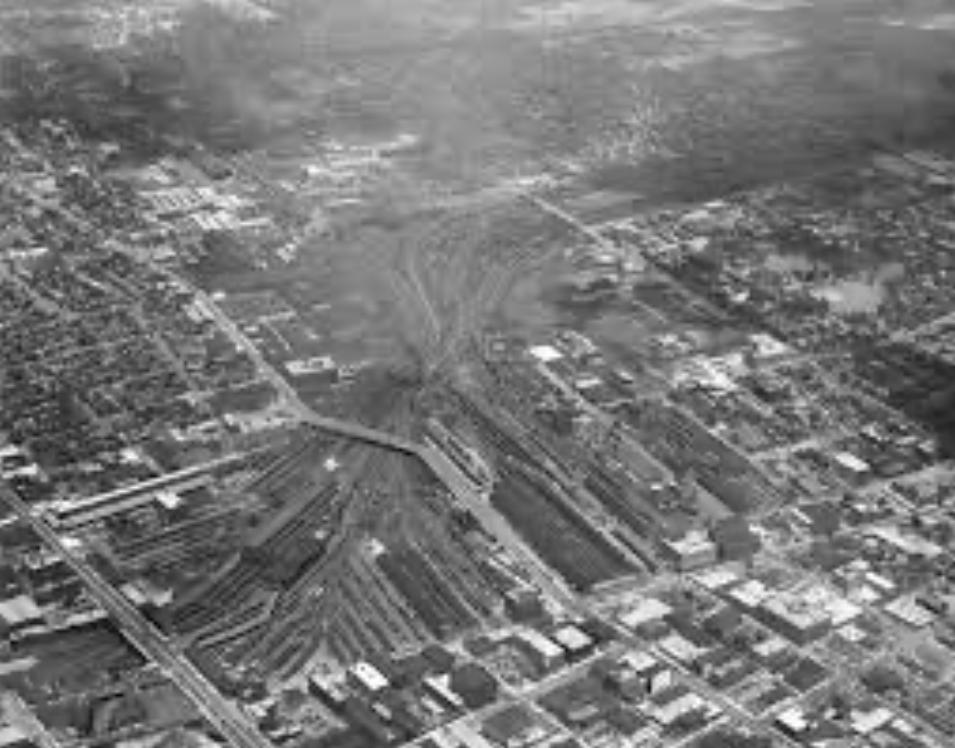North Market Historic District
The Beginning
As part of a city-wide commercial expansion, the North Market was established in 1876 by city ordinance. It was located just west of the Second Union Railroad Station on property then occupied by an unkempt cemetery, as was once a common practice. In addition to markets and parks, hospitals and schools were also built on dilapidated cemeteries. The area had grown during the Civil War, a time when little consideration could be given aesthetics or to long-term consequences, causing logistical issues. Train traffic crossing High Street caused buggies, wagons and people on foot to be held-up for over seven hours each day. A tunnel built under the tracks for horse-drawn trollies was meant to provide convenience but instead produced unbearable odors. Train transportation was the principal means of travel, so nearly everyone that came to Columbus entered into this filthy, chaotic epicenter.
By the 1890’s, as the city’s wealth and status grew, it wanted a grand entrance, a gateway that opened directly into the heart of the city; and the inhabitants needed relief from the paralyzing congestion and filth. The greatest American architect and urban designer of the day, Daniel Hudson Burnham, FAIA, was commissioned to recreate the area as an inviting shopping mecca equivalent in scale and splendor to the grand market-centers of Europe. Burnham had just finished his work as the Director of Works for the World’s Columbian Exposition in Chicago. He was also known for creating master plans for numerous cities, including Chicago and downtown Washington, D.C. Burnham was the unquestioned leader of the City Beautiful Movement.
The City Beautiful Movement sought to transform the urban environment into an idealized monumental cityscape that incorporated city planning, landscape, waterscape, lighting, and Beaux-Arts and neoclassical architecture. Advocates of the philosophy believed that beautification promoted a harmonious social order and therefore improved the quality of city life beyond mere aesthetics.
Burnham was commissioned to design a third Union Station; a station that would be as majestic as those in Chicago, Philadelphia and New York. The new Union Station opened in 1897, and the arcade opened in 1899. A key feature of the new station was the High Street viaduct over the tracks, finally solving the traffic/train problem. The Arcade consisted of stores built atop the viaduct and facing High Street. An elevated roadway connected Union Station to another train station several miles to the east, similar to how our major airport hubs connect terminals today with trams. The style of the stations was Beaux-Arts Classicism, a style often applied to monumental structures of the day. More than 160 passenger trains a day arrived at the new station. Thousands came to Columbus for shopping, government, business, tourism and education.
The horse-drawn trollies were replaced with electric street cars. Eighty million passengers a year rode the Columbus Railway Power & Light’s street cars; some rode to amusement parks like Indianola Park and Minerva Park, others rode to the Capital or The Ohio State University, while still others rode to the many opera houses and theaters or other live events. The north end of the city sparkled, both metaphorically and in reality, due to lighted arches that spanned over the city’s major thoroughfare. Columbus was called the most “brilliantly illuminated city in America.”
The transformation was astonishing. To the west of the Market District beyond High Street, warehouses and wholesale markets flourished. The properties near the Union Station became the most sought after and expensive property available in the state.
The address 463 North High sat at the very heart of the golden mile. It was purchased by the Parish Furniture and Rug Company and they built a five-story world-class showroom and retail center. The building was then and still remains the tallest and finest building in the North Market Historic District. The building featured a phenomenal two story glass front, constructed with the largest sheets of glass manufactured to date, a bronze elevator with a garden fresco painted ceiling, electric lights, public restrooms, exquisite woodwork, carpets, a fine pressed metal ceiling and grand stairs throughout.
To have a full appreciation of why such opulence was warranted, one needs to know a little about the economics of the day. First, Columbus and other areas in Ohio were booming manufacturing regions. More buggies, shoes, cigars, and farm tools were produced in Columbus than anywhere else in the world. Second, the years 1910-1914 became a statistical high benchmark for farm prices and profits. With railroad connections to eastern ports, Ohio was exporting to the world. In addition to being a major wheat producer, Ohio was number one for corn and wool production. The area had both natural resources and manufacturing to produce an explosion of expendable income. Grand mansions were being built on farmsteads, in streetcar suburbs, and in exclusive neighborhoods throughout Ohio. The residents of these new homes rode in tastefully appointed Pullman train cars to Union Station and when they emerged into Columbus through the station’s grand archways, the first sight they beheld was the Parish Furniture and Rug Company at 463 North High.
Upon entering the store, shoppers found treasures from around the world, displayed with royal elegance. They rode the elevator to floor after floor of displays, each more elegant than the one before: rugs from Prussia, the Ottoman Empire and India; furnishings, crystal chandeliers and porcelain from France and England; clocks from Germany and Switzerland; leather goods from Spain and Italy. For the more frugal shopper, the nearby Carlisle Furniture Store offered furnishings from Michigan, Massachusetts, Connecticut, New York and Ohio. The block was filled with shops and stores all offering the latest inventions, electrical devices and glamorous products. Shoppers placed their orders, and then dined in the area’s elegant restaurants on beef, lamb and oysters brought in by train from Maine, and stayed at luxury hotels with private bathrooms.
Decline
With the popularity of the automobile, falling farm prices and the weakening of manufacturing after WWII, the North Market area began to decline. By the mid-20th century these factors, combined with changes in demographics and shopping preferences left the North Market as the city’s only remaining public market. Even the North Market had fallen on hard times. After a 1947 fire, it moved into a Quonset hut and was barely hanging on.
On September 5, 1948, the last two fixed rail trams ran. A lack of investment in maintenance of the tracks, as well as the dawning age of the automobile had slowly brought the demise of the system. Union Station was dying, too. The number of daily passenger trains continuously declined. By 1970 there was just one a day, and then none. The businesses that once filled the arcades were closed and boarded up. The Parish Furniture and Rug Company, along with most of the retail block, was closed and the buildings sat abandoned. Even though the arcade had been listed on the National Register of Historic Places two years earlier, on October 22, 1976, the deteriorating arcade of the Union Train Station was demolished by a consortium led by the Battelle Memorial Institute. The area was blighted and bare, but the first urban pioneers had already began to arrive.
In 1965, Bob and Edith Holler moved their carnival supply warehouse to 463 North High. They expanded the business to include retail sales, becoming The Yankee Trader. Thousands of young boys and girls went there for birthday, bar mitzvah, and graduation decorations, as well as weddings, parties and showers. But the biggest day of the year for The Yankee Trader was Halloween. Hundreds of costumes, ranging from Betty Boop as a carhop, to a flying nun, were available for rent or purchase, as well as trinkets to pass out and decorations for home, school, or office.
The Return to Prominence
In 1982, the North Market District was nominated to the National Register of Historic Places by the Columbus Landmarks Foundation. In 1988, the not-for-profit organization, the North Market Development Authority, was established as part of a movement to restore the market to its former status as a vital part of the Columbus community. The suburbanization of the city had dealt the downtown area an economic blow, but the success of the movement to preserve Columbus’ German Village neighborhood provided an example of how neighborhood rehabilitation was possible. In December 1992, Nationwide Insurance sold the former Advanced Thresher Farm Machinery warehouse, which was located next to the market’s original location. After a $5 million rehabilitation, the warehouse reopened as the new North Market in November 1995, and the Quonset hut was demolished to make room for the market’s parking lot.
In 1988, Columbus city officials held a competition for the long-planned Greater Columbus Convention Center. Peter Eisenman was commissioned for the project. Noting that the site of the convention center had formerly been occupied by a train station, Eisenman pointed out that Columbus, in the age of information, was on-line with fiber- optic cables, vast flowing highways of information. For Eisenman, the railroad tracks, highways and cables all converged as contemporary symbols to inspire the design of the building. The Convention Center is composed of long fingers twisting their way between the truck docks at the back of the site and the abstract streetscape with front doors along High Street. Many of the lines of the building follow the original railroad tracks that once made Columbus a dynamic economic center. The new Greater Columbus Convention Center opened in 1993.
Even before the construction of the Convention Center, the district had begun to revive. The Japanese Steak House relocated from downtown to 479 High Street in 1990. In 1992 Barley’s Brewing Co. opened the first Ohio brew pub since prohibition at 476 North High. Martini’s opened Columbus’s first modern Italian restaurant at 445 North High.
Only the arch from the ornate structure of the Union Station was saved. It was re-erected in the district’s newly created McPherson Park in 2000. A cap was created in 2004 over Interstate 670. Similar to the Union Station’s Arcade in both function and design, it recalls its predecessor and is named “Cap Union Station.” A future streetcar has been proposed to be constructed in the future with the Yankee on High as its central stop.
In 2000 Edith Holler, the legendary owner of the Yankee Trader, passed away. Her two daughters kept the business operational for a decade, but with seasonal pop-up stores, online shopping and an economic recession, the business closed in 2010.
With the success of the North Market Historical District, Columbus Convention Center, the Short North District, the Arena District and Columbus Entertainment District, and as plans were being unveiled for the construction of a new 532 room Hilton Hotel just to the south, 463 North was again in the very heart of the action. As in 1900, it was again one of the most prominent and sought after pieces of real estate in Columbus. Studies were done and a determination was made to replace the Yankee, valued at $5.2 million with a new ten-story hotel. But others believed that too much of the District’s history had already been lost. So in order to save the building, Henry-Price LLC, quietly purchased the property in 2011. Clyde Henry and Dave Price along with other concerned Columbusites then formed Yankee Brothers, LLC, to restore the building. TRIAD Architects, one of Ohio’s premier design firms and the winner of the National Trust Award of Excellence, was selected to complete the design.
The design team understood this building and its place in Columbus’ Gilded Age, and wanted to create a concept that both captured the building’s elegant past, its iconic place in the district’s rebirth, and its dynamic future. The building’s mix of uses was as important as its design.
The upper floors are elegant lofts with soaring ceilings, in a stunning modern design, accented with the historical elements of the building. The restored wood floors blend effortlessly with the stainless steel and granite accents, the concealed lighting and original window woodwork. The authentic loft apartments are a true blend of the city’s past and future.
For the ground floor a relationship was formed with one of New York’s most innovative restaurant concepts. Starting in hip Brooklyn, NY, Bareburger is the future of classic food. The restaurant features organic, exotic burgers, beers and wines. The Bareburger at the Yankee on High is the first to open outside of the New York area.
On the mezzanine, Denmark introduces dynamic cocktails and small elegant bites in a Euro-style bar for the urban dwellers or the downtown executive. And for the convenience of travelers and downtown residents, a wine shop and party/conference room is located on the lower level.
TRIAD Architects so enjoyed this project that they relocated their office to the second floor. They found the location to be ideal for the firm in the heart of relevant and urban design.
This perfect mix of entertainment and living has once more put the Yankee on High at the crossroads of all that is exciting in the city. It has been a long journey. The North Market’s signature building, 463 is once more the address at the heart of the urban scene. With so much of the original North Market Historic District lost, today this building stands as the only one to be restored in accordance with the National Park Guidelines, the HRC, and in accord with the Best Practices of ARC.





